The more we travel in time, towards future, cloud computing keeps on captivating us with its mysterious enticing. The competition is heating up in the public cloud space as vendors regularly drop prices and offer new features. I will shine a light on the competition between the three giants of the cloud:Amazon Web Services (AWS), Google Cloud Platform (GCP), and Microsoft’s Azure.
AWS vs Azure vs Google: Compute
AWS’s EC2 (Elastic Compute Cloud) provides Amazon’s core compute service, allowing users to configure virtual machines using either pre-configured or custom AMIs (machine images). You select the size, power, memory capacity, and number of VMs and choose from among different regions and availability zones within which to launch. EC2 also allows load balancing (ELB) and auto scaling. ELB distributes loads across instances for better performance, and auto-scaling allow users to automatically scale available EC2 capacity up or down.
Azure users choose a VHD (Virtual Hard Disk), to create a virtual machine. A VHD can be either predefined by Microsoft, by third parties, or be user-defined. With each VM, you need to specify the number of cores and amount of memory.
In 2012, Google introduced their computing cloud service: Google Compute Engine (GCE). Google Compute Engine lets users launch virtual machines into regions and availability groups. Google has added its own enhancements, like load balancing, extended support for Operating Systems, live migration of VMs, faster persistent disks, and instances with more cores.
AWS vs Azure vs Google: Networking
Amazon’s Virtual Private Clouds (VPCs) and Azure’s Virtual Network (VNET) allow users to group VMs into isolated networks in the cloud. Using VPCs and VNETs, users can define a network topology, create subnets, route tables, private IP address ranges, and network gateways. There’s not much to choose between AWS vs Azure on this: they both have solutions to extend your on-premise data center into the public (or hybrid) cloud. Each Google Compute Engine instance belongs to a single network, which defines the address range and gateway address for all instances connected to it. Firewall rules can be applied to an instance, and it can receive a public IP address.
AWS vs Azure vs Google Cloud: Storage
AWS provides temporary storage that starts working once an instance is started and stops when the instance is terminated. AWS also provides Block Storage, equivalent to hard disks, which can either be attached to any instance or kept separate. AWS also offers native cloud object storage solution, S3, that comes with high availability and automatic replication across regions.
Azure utilizes temporary storage and Page Blobs for VM-based volumes. Microsoft’s Block Storage option, i.e. the Page Blobs and Files act similar to S3 in AWS and serve as Object Storage units. Azure provides two classes of storage, Hot and Cool, classified based on their price. Cool comes at a lower storage cost, in comparison to Hot, but incurs additional read and write costs.
Google Cloud Platform also offers both temporary storage and persistent storage disks. Google Cloud Storage services serve the purpose of object storage for the Google Cloud Platform.Object storage services of Google Cloud are categorized as Standard, Durable Reduced Availability and Nearline storage classes with Durable Reduced Availability being the cheapest choice for data.
AWS vs Azure vs Google Cloud: Databases
AWS works seamlessly with relational as well as NoSQL databases. AWS also supports Big Data. The core analytics offering of AWS is Elastic MapReduce (EMR), a managed Hadoop, Spark, and Presto solution, which helps setting up an underlying EC2 cluster and provides integration with a number of AWS services.
Azure supports both relational and NoSQL databases, as well as Big Data, through Windows Azure Table and HDInsight. Azure offers a number of NoSQL options including DocumentDB, Azure’s flagship high-performance document database. Azure also provides a suite of analytical products called Cortana Intelligence that comes with Hadoop, HBase, Spark or Storm.
Google Cloud Platform supports relational databases through Google Cloud SQL while its NoSQL option is Google’s general purpose document database, Cloud Datastore. Google Cloud Platform’s support for Big Data and Analytics is backed by Cloud Dataproc, a fully managed Hadoop and Spark offering. Being the quickest of the three providers, Google boasts of a 90 second lead time to start or scale Cloud Dataproc clusters.
AWS vs Azure vs Google Cloud: Pricing
Customers using AWS are charged by rounding up the number of hours used. It allows customers to buy instances using any one of the following models:
On Demand – pay for what you use without any upfront cost
Reserved – reserve instances for 1 or 3 years with an upfront cost based on the utilization
Spot – bid for the available extra capacity
Azure lets customers use its services on demand. If you are using Azure, you will be charged by rounding up the number of minutes used. Azure also provide short-term commitment opportunities with discounts.
Google charges its users for instances by rounding up the number of minutes used, with a minimum of 10 minutes. Google Cloud Services also offers a sustained-use pricing structure that automatically discounts the on-demand baseline hourly rate when a particular instance is used for a longer period in a month.

Different Discount options for clouds:-
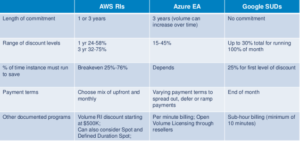
Aws vs azure vs google cloud instances types :-
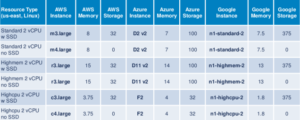
On demand prices for all three giants:-
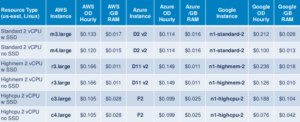
Billing per minute structure for:
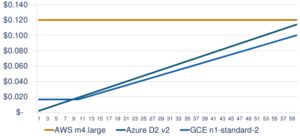
Billing per minute structure for: >1 hour
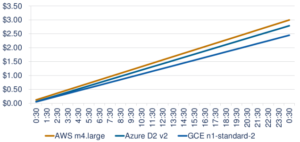
Linus vs Windows :
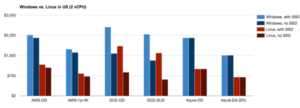
Storage Comparision:
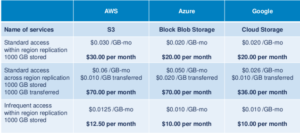
Lock storage comparision:
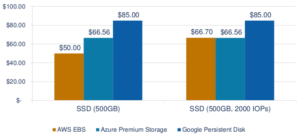
With whom to go?
In this article, I have tried to throw some light on the AWS vs Azure vs Google Cloud debate. But, whatever the comparisons may be, finding the apt public cloud provider means researching what one really needs and what that provider has to offer.
One conclusion that comes out of the AWS vs Azure vs Google Cloud services battle is that the customers are going to win big as each public cloud service provider continue to woo them with regular price cuts and expanded offerings.
Check out what services provide @product development services









